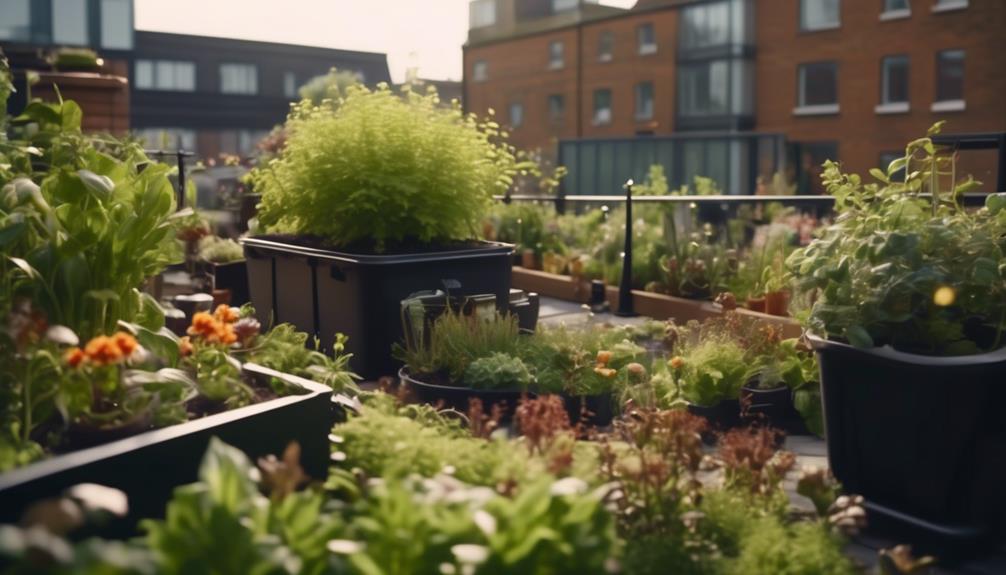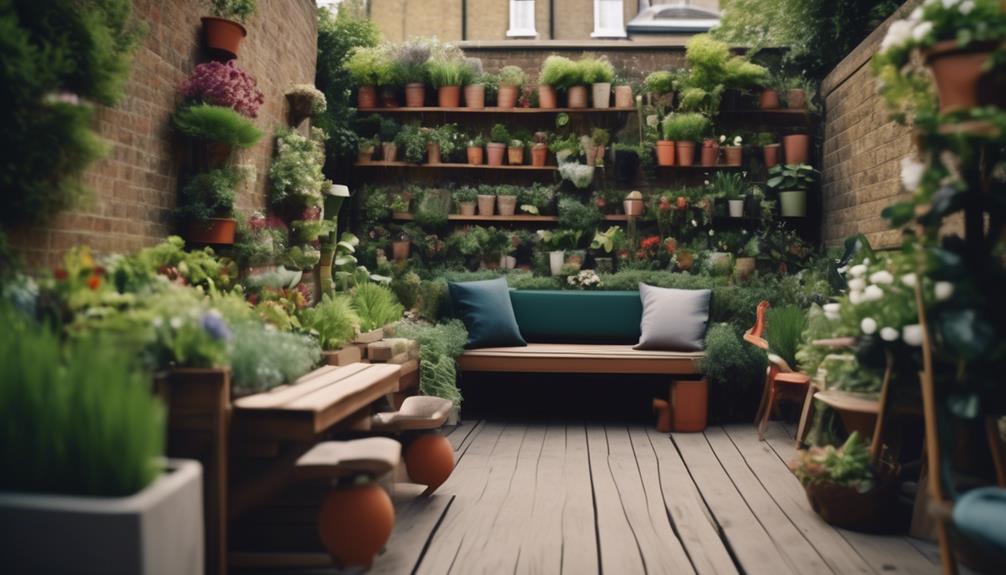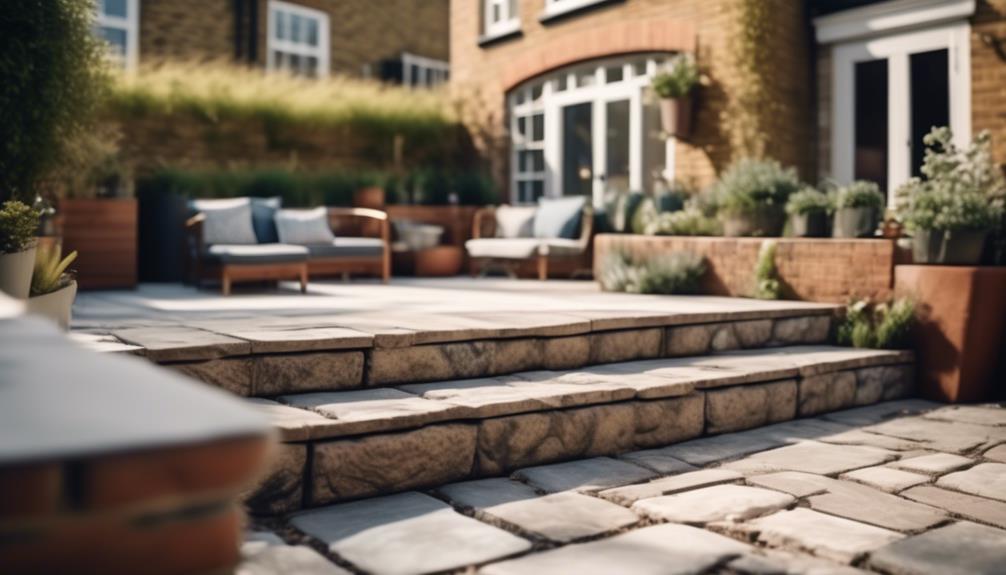During my recent stroll through London’s bustling streets, I couldn’t help but notice how the city’s outdoor spaces are akin to a fragile ecosystem. Just like a delicate web of interconnected elements, our outdoor living spaces in London require a thoughtful approach to sustainability.
From eco-friendly materials to renewable energy sources, there are numerous ways we can ensure that our outdoor living areas not only thrive but also contribute to a healthier environment.
But how can we achieve this in the midst of a bustling metropolis? Let’s explore five practical and resourceful ways to create sustainable outdoor living in London, each with the potential to transform our urban spaces into vibrant, eco-conscious havens.
Key Takeaways
- Choose eco-friendly materials and furniture options such as reclaimed wood and recycled plastic for sustainable outdoor living in London.
- Harness renewable energy sources like solar panels and wind turbines to power outdoor amenities and reduce environmental impact.
- Implement water conservation strategies like rainwater harvesting and using drought-resistant landscaping to minimize water usage.
- Embrace urban gardening and greenery through rooftop gardens, containers, and community composting to promote biodiversity and locally grown produce in the city.
Choosing Eco-Friendly Materials
When selecting materials for sustainable outdoor living in London, I prioritize those that aren’t only eco-friendly but also durable and low-maintenance. For sustainable flooring options, I opt for materials like reclaimed wood, bamboo, or composite decking made from recycled plastic and wood fibers. These choices not only reduce the demand for new timber but also offer longevity and resistance to the elements, making them ideal for outdoor spaces in London’s varying climate. Additionally, these materials often come with easy installation and require minimal upkeep, aligning with the practicality I seek in sustainable outdoor living.
In terms of eco-friendly furniture choices, I look for pieces made from recycled materials or sustainably sourced wood. Furniture crafted from reclaimed wood not only adds a unique character to the outdoor space but also contributes to reducing environmental impact. Furthermore, opting for outdoor furniture made from recycled plastic not only diverts plastic waste from landfills but also offers durability and weather resistance. These choices reflect my commitment to creating an environmentally conscious outdoor living space without compromising on style or functionality.
Incorporating Renewable Energy Sources
To enhance the sustainability of my outdoor living in London, I am exploring the integration of renewable energy sources to power lighting, heating, and other outdoor amenities. One of the most practical ways to achieve this is by incorporating solar panels and wind turbines into the outdoor space. Solar panels can be installed on rooftops or in open areas to harness the abundant sunlight in London, converting it into electricity to power outdoor lighting and heating systems. Similarly, wind turbines can be strategically placed to capture the wind energy, providing an additional renewable power source for outdoor amenities.
| Renewable Energy Source | Benefits | Considerations |
|---|---|---|
| Solar Panels | – Harnesses sunlight<br>- Low maintenance<br>- Long lifespan | – Initial cost<br>- Installation space |
| Wind Turbines | – Captures wind energy<br>- Suitable for urban areas<br>- Low environmental impact | – Noise concerns<br>- Local regulations<br>- Aesthetics |
Implementing Water Conservation Strategies
Incorporating renewable energy sources has been pivotal in my pursuit of sustainable outdoor living in London. Now, I’m turning my focus to implementing water conservation strategies to further enhance the eco-friendly nature of my outdoor space.
Rainwater harvesting is a key component of my water conservation strategy. By installing rain barrels or a cistern, I can collect and store rainwater to use for watering plants, reducing the need for treated municipal water.
Additionally, I’m incorporating drought-resistant landscaping with native plants that require minimal watering, thereby conserving water resources.
Greywater recycling is another technique I’m embracing. I plan to reuse water from activities like bathing and laundry for irrigation, ensuring that no water goes to waste.
Furthermore, I’m investing in water-efficient irrigation systems such as drip irrigation or soaker hoses to deliver water directly to the roots of plants, minimizing evaporation and runoff.
These practical water conservation strategies not only contribute to a sustainable outdoor living space but also foster a deeper connection with nature and environmental stewardship.
Embracing Urban Gardening and Greenery
As I explore the concept of sustainable outdoor living in London, my focus now shifts towards embracing urban gardening and greenery to further enhance the eco-friendly nature of my outdoor space.
Rooftop gardens offer a practical solution for those with limited ground space, providing an opportunity to grow herbs, vegetables, and even small fruit trees. Containers and raised beds can also be utilized to maximize greenery in urban settings.
Additionally, community composting is an excellent way to reduce waste and nourish urban gardens. By participating in community composting initiatives, I can contribute to the creation of nutrient-rich soil for my urban garden while diverting organic waste from landfills.
Engaging in urban gardening not only adds natural beauty to my outdoor space but also promotes biodiversity and provides a source of fresh, locally grown produce. It’s a hands-on way to connect with nature in the midst of the city while actively contributing to a more sustainable environment.
Promoting Sustainable Lifestyle Practices

I actively engage in sustainable lifestyle practices to minimize my environmental impact and foster a more eco-conscious community. Community engagement is key in promoting sustainable living. I participate in local eco-events, organize neighborhood clean-ups, and share eco-friendly tips with friends and family. By involving others, we can create a ripple effect of positive change.
Sustainable transportation is another crucial aspect. I prioritize walking, cycling, and using public transport. London has excellent bike-sharing schemes and extensive public transit networks, making it easier to reduce our carbon footprint. Additionally, I advocate for the use of electric vehicles and carpooling whenever possible.
In my daily life, I’m mindful of energy and water usage, reduce waste through recycling and composting, and support local businesses and farmers’ markets to minimize carbon emissions from transportation. Small actions, when multiplied by many, can make a significant difference.
I also encourage others to adopt these practices, as collective efforts lead to a more sustainable and harmonious community. Let’s inspire and empower each other to make conscious lifestyle choices for the well-being of our planet and future generations.
Frequently Asked Questions
How Can I Ensure That My Outdoor Living Space in London Is Compliant With Local Sustainability Regulations and Standards?
To ensure my outdoor living space in London complies with local sustainability regulations and standards, I focus on using sustainable materials and energy-efficient lighting. It’s important to research and implement eco-friendly options to minimize environmental impact.
Are There Any Government Incentives or Rebates Available for Incorporating Renewable Energy Sources Into My Outdoor Living Space in London?
Yes, there are government incentives and rebates available for incorporating renewable energy sources into my outdoor living space in London. It’s cost-effective to consider solar panels as a sustainable solution.
What Are Some Creative Ways to Effectively Capture and Reuse Rainwater in an Urban Outdoor Living Setting in London?
Capturing and reusing rainwater in an urban outdoor living space is key for sustainability. With smart urban design, rainwater harvesting systems can be integrated into the landscape, conserving water and reducing environmental impact.
Can You Provide Tips for Maximizing Limited Space for Urban Gardening and Greenery in a Sustainable Way in London?
Maximizing limited space for urban gardening in London involves container and vertical gardening. Using eco-friendly materials and incorporating green roofs can enhance sustainability. These methods create lush, green outdoor spaces in the city.
How Can I Encourage My Community to Adopt Sustainable Lifestyle Practices in Their Outdoor Living Spaces in London?
Encouraging community engagement is key. Hosting sustainable events, promoting green infrastructure, and advocating for waste reduction can inspire others. By leading through example and fostering a sense of togetherness, we can create a more sustainable outdoor living culture in London.
Conclusion
In conclusion, creating sustainable outdoor living in London is achievable through mindful choices and practical strategies.
By selecting eco-friendly materials, incorporating renewable energy sources, implementing water conservation strategies, embracing urban gardening and greenery, and promoting sustainable lifestyle practices, we can make a positive impact on the environment.
With attention to detail and resourceful planning, we can create outdoor spaces that aren’t only beautiful and functional but also eco-friendly and sustainable for the future.

